Greg Saulnier is paid to be picky. At 44, the Rumney, New Hampshire, native has been looking at logs for 15 years, first as a logger and for the last eight years as a log buyer for Columbia Forest Products. His work has him crisscrossing New Hampshire, from the seacoast to the Connecticut River and up to Franconia Notch, stopping at log landings and buying truckloads of very expensive veneer logs.
A perfect veneer log, if there were such a thing, would be a true cylinder. And inside that perfect log, all the growth rings would be the same distance apart, and the wood would be uniform with no blemishes and no discolored wood. But perfection doesn’t come easily, compromised as it is by the nature of how trees grow. Big trees start out as saplings with branches forming from the center stem. Both stem and branch grow in length and girth. When the tree is cut and its logs are sawn, sliced, or peeled, the remnants of those branches are visible as dark wood and show up as knots. If the branch is pruned or falls off on its own, the stub gets covered over with a layer of new wood each year as the tree’s girth expands. Logs cut from trees that have grown many inches of clear wood over those branch stubs, enough wood that the stub no longer shows up as a protrusion in the bark, are the objects of Greg Saulnier’s quest.
If you were to split a log in half from end to end, you could see the branch remnants and how much clear wood there is, but of course Saulnier can’t do that. He has to predict what’s inside by looking at the log’s end, evaluating its shape, and examining its bark. He places a bet on his prediction by giving the log a grade that (combined with the log’s volume) determines how much he pays for it.
A truck with a load of veneer logs carries an average of 4,000 board feet in 56 to 58 logs. With a difference in price between $4,000 per thousand board feet (MBF) for a top grade to $1,000 per MBF for his mid-range grade of sugar maple, he’s spending between $4,000 and $16,000 for that load of logs. Only later, when they put the log on the lathe in Newport, Vermont, or Presque Isle, Maine, and start peeling it, do they find out if the money was well spent. With all that riding on his judgment, you might think Saulnier would agonize over each decision.
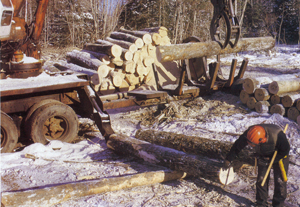
But for most logs, it takes him no more than a minute to evaluate it, enter the information into his hand-held computer, and hammer a metal bar code onto the end of it. Here’s how it went one bitterly cold day last January.
While Saulnier and I were heading north on I-93, his cell phone rang. Logging contractor Bud Foster and his son, Bud Jr., were waiting for Saulnier to arrive at their landing in Dalton, New Hampshire, and they called him to make sure he was on his way. Hanging up the phone, Saulnier says, “I don’t know how anybody could have done this job before these things.” He’ll typically schedule a series of three or more stops in a day, and with everybody in the logging business now equipped with a phone, there are no longer any full days lost to a cascading catastrophe started with a truck breakdown or some other snafu. A couple of calls, and new arrangements are in place.
When we reach the landing, Foster tells me he has been selling logs to Columbia since 1968. He and Saulnier spend little time on pleasantries because the temperature on the log landing is 15 degrees below zero, though it doesn’t appear that the cold bothers either of them. Saulnier’s only concern with the cold is that it not shut down his hand-held computer, which happens on occasion. He leaves his pickup running with the heat on in case he needs to warm the computer up.
Foster has a large pile of logs behind his loader, the pile positioned so he can pick up a log or two behind him and swing them around to the front, where he places them on a crib of two logs set crosswise to keep them elevated. That way Saulnier can see nearly the whole log. Foster presents the logs so their smaller end is facing Saulnier. Both men are wearing ear protection, but they communicate easily through hand signals. Without ever speaking a word, Saulnier tells Foster, “I don’t want to buy that one,” “Let me see the bottom of this one,” and “Spin it so I can see the other end.” Sitting in the cab, his hands on the levers, Foster quickly obliges.
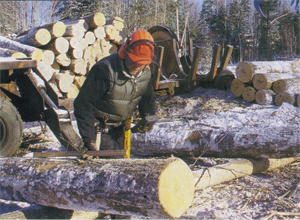
Sweep is the first thing Saulnier will notice. One of the first logs he sees has too much sweep, and Saulnier says, “Here’s a big, fat, beautiful log, but it’s way too crooked.” He’s after logs that are straight from end to end and will not buy any that have a hint of a banana shape. A defect like sweep is a deal-killer for almost all veneer buyers, with the exception being those mills, such as Rutland Plywood, that re-saw full-length logs (9-foot 5-inches or longer, in 1-foot increments) into 3- to 4-foot lengths and turn them on a short-block rotary mill.
Next, he looks at the log’s end to make sure that its heart is centered and relatively small. If the heartwood accounts for more than one-third of the log’s diameter, he won’t buy it. He also looks for any discoloration in the wood and splits in the end. If a crack in a log runs the entire diameter from bark to bark, he can’t buy it.
His eyes are quick, and he takes in the log’s end and relative straightness with what seems just a glance, but when he gets to the bark, he slows down. He walks along the log, whacking crusted snow off it with his scale stick – it looks like a heavy-duty yardstick with a metal hook on its end – commenting sheepishly that he’d broken his favorite scale stick the day before doing just that. Most of Foster’s logs are sugar maple (along with an occasional white ash, yellow birch, or white birch), and Saulnier says that these other species are simple to read compared to sugar maple. “Maple is the toughest to grade. It can make you look heartless.”
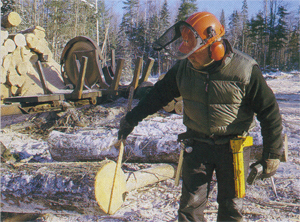
As he knocks the snow off, he’s looking for subtle bark patterns that indicate an overgrown knot or other defect. If a log has a scar from a wound, he won’t take it. “Scars are worse than knots. Scars start the degradation, and after six years, the rot will ruin the log.” This log has one overgrown knot and a heart whose diameter is less than one-third the log’s diameter. He uses his scale stick to measure the diameter inside the bark on the small end of the log: 14 inches. And he confirms the log’s length, also with the scale stick. The stick is 3 feet long, so starting at the far end, he walks along the log, flipping it end over end three times to get the 9 feet that he’s looking for. His three flips of the stick bring him to a point at least 5 inches short of the end of the log, which means the log has the 5 inches of trim (extra log length) that Columbia and other buyers require. He tucks the stick under his arm and punches the information into the computer: diameter, length, grade.
Sugar maple has a range of nine grades in the Columbia system, with the bottom five grades competing as much with sawmills as with other veneer buyers. This 14-inch log with one defect is a 1S grade (the fourth-highest grade), measures 70 board feet, and brings Foster $140 at a price of $2,000 per MBF. The same size log with no defects and a perfectly centered heart would bring twice that.
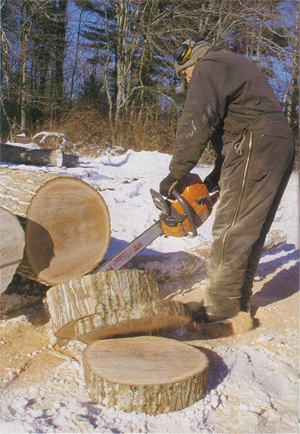
Saulnier then takes out his tagging hammer, attaches a bar code tag from his dispenser, and with a quick backhand, he pounds it onto the end of the log. He has also written the grade and the volume in blue ink on the end of the log. Why record this information twice? The bar code is Columbia’s means of keeping track of its logs. Whether it’s in the log yard in Newport, Vermont, or Columbia’s other northeastern mill in Presque Isle, Maine, they’ll know it’s a log Greg Saulnier bought from Bud Foster. And they’ll know what he paid for it.
The pen mark, on the other hand, is for the logger’s benefit, so that he can confirm the grade and scale the log’s been given. Said Saulnier, “After I leave, they can take a look at how I graded all the wood. And that’s good.”
About one log in five will require more scrutiny. Sometimes, he doesn’t like what he sees in the end, so he asks Bud Jr., who’s been standing by with his chainsaw, to take a slice off the end at the line Saulnier gives him with his marking pen. By clipping it, he’s trying to get rid of end defects, such as knots, discolorations, and splits or cracks. By removing some wood, he removes that which would give it a lower grade.
Each of the three men gets his job done quickly and efficiently, and before long, Foster signals to Saulnier that he’s got a full load. Saulnier goes to his truck and hooks a cable from his computer to his printer, which runs off an inverter plugged into the cigarette lighter. Within seconds, he prints out in triplicate (a copy each for logger, truck, and buyer) a full list of the logs, the grades, and the price he’s paid. He hands Foster his copies (he does his own trucking), and they arrange for a return visit to take a look at the rest of the pile.
Working with new sellers
On the way down the interstate to the next job, the phone rings again. It’s a landowner who says he’s got some really nice white ash he wants to sell. The cell phone is a hands-free model, so I am privy to both ends of the conversation. Saulnier says he’ll fax him a rate sheet that evening, but he keeps the conversation going, asking lots of questions. When he asks who’s doing the logging, the answer is vague, ringing an alarm for Saulnier, who wants to be sure it’s done by a professional. He offers to stop by and take a look once the job gets started, making it sound like it’s a service he’d be pleased to provide, but by doing so he can reassure himself of the quality of the wood. The last thing he wants to do is schedule a truck to come to a landing and find out the wood is no better than pulpwood. Making truckers unhappy is something he tries to avoid.
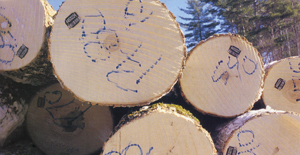
Having spent many years himself in the logging business is a big asset because Saulnier understands the challenges loggers face trying to make a living. He also knows how things have changed since he traded in his skidder for a company truck. “It used to be you’d sell all your wood to your local mill. That doesn’t happen anymore. Now most loggers have a computer and access to a lot of pricing information. They’re much more aware of markets.”
Consequently, on almost any landing in the region, the logger will have his logs sorted into many piles based on their end use. There will be a pile of pulpwood, a few separate piles of sawlogs based on species, quality, and markets, and a pile of veneer. There might even be two veneer piles, since some loggers set their best logs aside for the slicer markets.
Buyers for slicer veneer mills (where logs are cut into thin, parallel slices) pay big prices for the largest and best logs. Columbia, which operates a rotary veneer mill that peels a continuous thin sheet of veneer off the log, has had to raise its prices to stay competitive with the slicer buyers. “Slicer? We don’t even like to hear the s-word mentioned,” Saulnier says. “We’re in fierce competition with the slicer people.”
The key to successful buying is building a relationship with a logger that’s based on trust, Saulnier says. He’s proud of the loyalty many of his suppliers show by selling him all their veneer logs, and he does everything he can to keep them happy. “The competition is brutal. There’s seven other guys in the bushes would love to have this wood.”
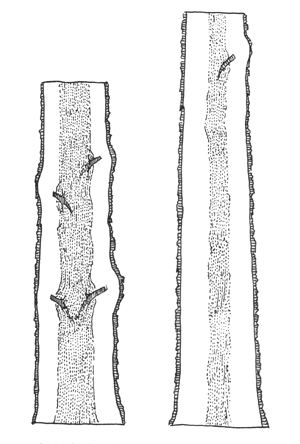
After lunch, we stop in to see a logger who had called Columbia’s office about selling them some logs. Saulnier’s pickup winds its way up a long goat track to the log landing. The negotiations begin immediately as the logger tells Saulnier he’s already getting a good straight-through price elsewhere for his wood and that he’s not sure he’s going to sell any to Columbia. Saulnier looks at the pile of white ash and says that he would pay $600 per MBF for most of the wood in that pile. He then walks over to the white birch pile, peers at the end of a log, and points out worm track. “If you see it in one log on a lot, it’s probably going to run through the whole lot.” To which the logger replies, “Don’t you start getting too fussy with me or I’ll send you right down the road. I’d just as soon sell it all to the Canadians.”
The sparring continues, and as he gets back in his truck, Saulnier tells him to call him if he wants to sell some wood. As we drive away, Saulnier says, “That’s a classic first conversation with a new logger. It’s invariably adversarial. They want to make sure they don’t get screwed. So I need to work to build the relationship. This one’s a project for me, and I like the challenge.”
The last stop of the day is in the Lakes Region, a load of red oak. As we drive in through a working dairy farm, he says, “A lot of the nice timber we buy is from grown-up farmland.” Red oak is not bringing the high prices that sugar maple and black cherry do, but Saulnier’s prices range from $500 to $1350 per MBF. The highest quality red oak slicer veneer is going for only slightly more than Columbia’s top price.
Red oak is easier to grade than maple because the defects are more readily apparent in the bark. Overgrown branch stubs show up in the bark as a cat’s face. But there’s a whole different set of problems to be looking for. Oak is more likely to have a heart that’s off-center. It’s prone to grub holes, and it can have what’s known as shake – cracks in the wood along growth rings.
This job goes more slowly than the morning’s stop. Like a number of Saulnier’s suppliers, Parker Rowe leaves many of the logs overly long, leaving it up to Saulnier to mark where they should be cut. Those decisions are more difficult than usual with oak, because these logs are particularly large, coming from old trees. The log loader is an older, slower model and labors to handle the logs, always one at a time.
By now, the temperature has maxed out at around zero, and the sun is about to hide behind the hillside. I have one question left to ask: “Have you ever had a thousand-dollar log?”
“No, but I have had a thousand-dollar tree. It was a sugar maple with a 23-inch diameter in the butt log, and it had three logs in it, all of them with tiny hearts. I paid $1,200 for that tree,” he said. And in his voice, I could hear pride for having bought such a spectacular tree, and what can only be described as a sense of wonder for the tree itself.


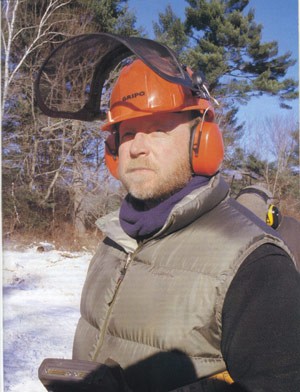
Discussion *